INDEX
- English
- 日本語
- English
- 日本語
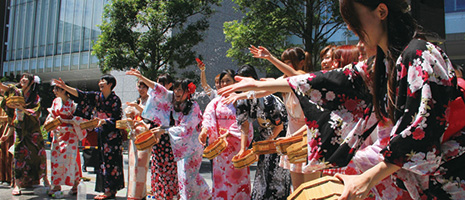
Uchimizu
Uchimizu, sprinkling water on streets and yards, is a Japanese practice carried out to provide relief from the summer heat through the effect of vaporization. More recently, uchimizu is also being seen as a means of dealing with the heat island effect and global warming.
Unique Ways of Using Water in Japan
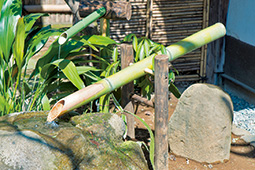
Shishi-odoshi
Shishi-odoshi (“deer-scare”) is a device that uses water and sound to give Japanese gardens an elegant atmosphere. The structure is a hollow bamboo tube that moves up and down like a seesaw with its center as the fulcrum. The weight of the water flowing into the tube is used to move it up and down, so that one of the sides strikes a stone on the ground and makes a pleasing sound. The sound was originally used to drive away pesky deer and wild boar that would ravage the fields.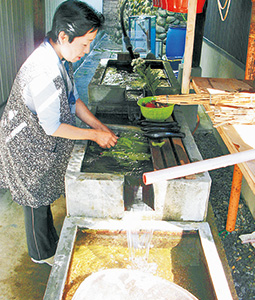
Mizubune
The city of Gujo in Gifu Prefecture has a unique water system called mizubune, meaning “water boats.” It is a system where two or three water basins are placed next to each other at different heights in the home and into which water flows from springs or mountain streams. The residents use the water in the top basin for drinking and to rinse food, while the water in the bottom basin is used to wash dishes and for other household cleaning. Any food scraps left in the bottom tank become feed for the carp in the house pond. In this system, the water is naturally purified and flows into the river.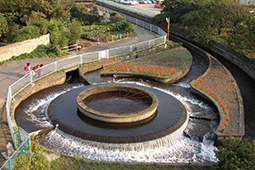
Circular Tank Diversion
Circular tank diversion is a system for distributing agricultural water fairly to prevent conflicts over water among farmers. Water from rivers and other resources are diverted into a cylindrical basin with the water from the basin then flowing into irrigation channels leading to the surrounding plots of farmland. By dividing the basin’s circumference in a way that is proportional to the size of the plots where the water is distributed, the volume of water flowing into each irrigation channel is fair.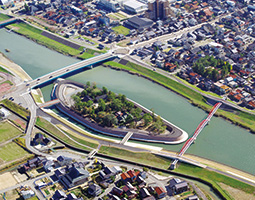
Waju Ring Levees
Areas near rivers are often suitable for agriculture, having abundant water input and fertile soil sustained by the river. However, downstream and river confluence areas in particular are at risk from flooding. To counter this, communities in some areas have built what are known locally as waju (wa means “ring” and ju is an area surrounded by a ring levee), surrounding their villages with successive levees (embankments) to protect their houses and farmland.
July 2021
Water and Japan

Uchimizu, sprinkling water on streets and yards, is a Japanese practice carried out to provide relief from the summer heat through the effect of vaporization. More recently, uchimizu is also being seen as a means of dealing with the heat island effect and global warming.
Japan is pursuing initiatives to make effective use of its limited water resources and engaging in international cooperation on water-related issues.
Japan’s Water Resources
Average annual precipitation in Japan is 1,668 mm, which is 1.6 times the global average. However, Japan’s rivers are short and the water quickly flows into the sea due to its precipitous geography. Moreover, the amount of habitable land is limited and the population density high, so the amount of usable water available per person in Japan per year is 3,373 m3 (equivalent in volume to about seven 25-meter swimming pools), which is about half the global average.
This is why Japan has for many years been investing in the development of water resources. One example is dam construction. Dams play roles including flood control—storing massive amounts of water inflow water upstream to reduce downstream flood damage by controlling the water flow—and maintaining the normal functions of a river such as by releasing its stored water when the downstream river flow is insufficient. Japan has 2,650 dams (as of the end of March 2018), which enables stable water use throughout the year.
To increase citizens’ interest in and deepen understanding of the finiteness of water, the preciousness of water, and the importance of developing water resources, Japan has designated the first day of August as “Water Day”—since August is a month when a lot of water is used—and the first week of the month as “Water Week.” A number of events are held during “Water Week,” including the promotion of uchimizu (the sprinkling of water on streets to cool the surrounding area) and holding a “National Writing Competition on Water for Junior High-School Students” and an “Interactions with Water Photo Contest.”
International Cooperation on Water
Japan has worked to guarantee a stable supply of tap water domestically for many years. As a result, Japan’s water supply pipelines have a total length of about 670,000 km. The tap water supplied has to conform with fifty-one water quality criteria, including for E. coli bacteria, lead, and taste. It is thanks to this strict safety management that Japan’s tap water boasts one of the world’s highest levels of safety.
Using its advanced technology, Japan has long been providing official development assistance (ODA) in the areas of water supply development and public hygiene, and is the world’s top provider of assistance in these fields among the countries providing foreign aid, recording a five-year average of about 1.39 billion dollars between 2013 and 2017. Japan is giving comprehensive support for infrastructure development and human resource development mainly in developing countries in Africa and Asia.
Japan is also strengthening international cooperation on water-related issues. In 2018, Japan founded the Asia Wastewater Management Partnership (AWaP) together with five other Asian countries. AWaP has an aim of “halving the proportion of untreated wastewater,” which is one of the targets of the Sustainable Development Goals (SDGs), and is promoting wastewater treatment in Asia.
The 4th Asia-Pacific Water Summit, which is an international meeting for raising awareness about water issues and encouraging concrete resource mobilization and action, is planned to be held in Kumamoto City in April 2022, and Japan is working to strengthen international cooperation for resolving global water resource issues and achieving the SDGs.
Unique Ways of Using Water in Japan

Shishi-odoshi (“deer-scare”) is a device that uses water and sound to give Japanese gardens an elegant atmosphere. The structure is a hollow bamboo tube that moves up and down like a seesaw with its center as the fulcrum. The weight of the water flowing into the tube is used to move it up and down, so that one of the sides strikes a stone on the ground and makes a pleasing sound. The sound was originally used to drive away pesky deer and wild boar that would ravage the fields.

The city of Gujo in Gifu Prefecture has a unique water system called mizubune, meaning “water boats.” It is a system where two or three water basins are placed next to each other at different heights in the home and into which water flows from springs or mountain streams. The residents use the water in the top basin for drinking and to rinse food, while the water in the bottom basin is used to wash dishes and for other household cleaning. Any food scraps left in the bottom tank become feed for the carp in the house pond. In this system, the water is naturally purified and flows into the river.

Circular tank diversion is a system for distributing agricultural water fairly to prevent conflicts over water among farmers. Water from rivers and other resources are diverted into a cylindrical basin with the water from the basin then flowing into irrigation channels leading to the surrounding plots of farmland. By dividing the basin’s circumference in a way that is proportional to the size of the plots where the water is distributed, the volume of water flowing into each irrigation channel is fair.

Areas near rivers are often suitable for agriculture, having abundant water input and fertile soil sustained by the river. However, downstream and river confluence areas in particular are at risk from flooding. To counter this, communities in some areas have built what are known locally as waju (wa means “ring” and ju is an area surrounded by a ring levee), surrounding their villages with successive levees (embankments) to protect their houses and farmland.
Note: This article has been created with the consent of the Ministry of Land, Infrastructure, Transport and Tourism and on the basis of materials published by the Ministry.

